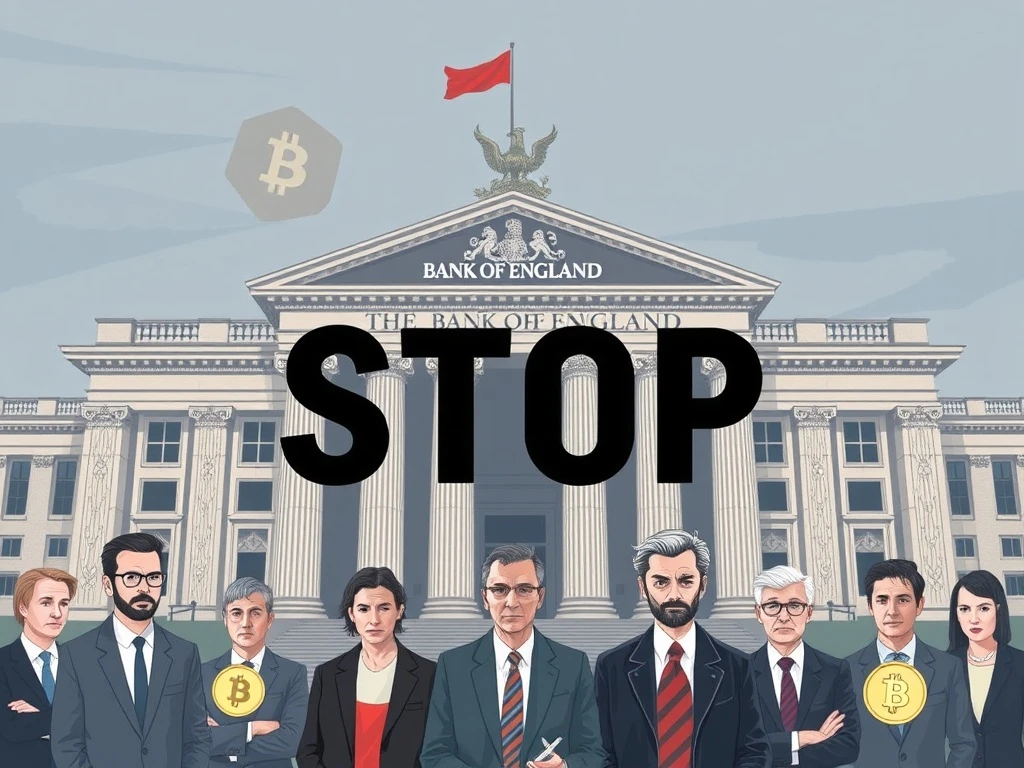Urgent: Bank of England Stablecoin Limits Spark **Furious** Backlash from UK Crypto Groups

The financial world is buzzing with a critical debate. Recently, UK crypto and payments groups have launched a fierce criticism against the Bank of England’s (BoE) proposed limits on individual stablecoin holdings. This pivotal discussion highlights growing tensions between traditional financial institutions and the rapidly evolving digital asset sector. Industry leaders warn these restrictions could severely hinder innovation and leave the UK lagging behind global competitors in the burgeoning crypto economy. Understanding these concerns is crucial for anyone interested in the future of finance.
Bank of England Stablecoin Proposal: A Closer Look
In November 2023, the Bank of England unveiled a discussion paper. This document outlined potential caps on individual holdings of a future digital pound, ranging from £10,000 to £20,000. Furthermore, the bank even sought feedback on a possible lower limit of £5,000. These proposed restrictions aim to manage perceived risks within the financial system. However, industry stakeholders quickly voiced significant opposition. Many believe such stringent measures could stifle growth. They argue that these limits are both impractical and potentially damaging to the UK’s standing in the global digital finance landscape.
UK Crypto Groups Slam Proposed Digital Pound Limits
Leading advocacy groups within the United Kingdom’s cryptocurrency industry have united to challenge the Bank of England’s plans. According to a recent Financial Times report, these groups assert that implementing such limits would be both expensive and exceedingly difficult. Moreover, they contend that the UK risks falling behind other major jurisdictions that have not imposed similar restrictions. Tom Duff Gordon, Vice-President of International Policy at Coinbase, expressed strong reservations. He reportedly stated that these limits would negatively impact UK savers and even the stability of the pound itself. “No other major jurisdiction has deemed it necessary to impose caps,” he highlighted, underscoring the UK’s potentially isolated position.
The sentiment among **UK crypto groups** is clear: the proposed caps are a misstep. They argue that a forward-thinking approach requires embracing, not restricting, the potential of digital assets. The industry believes that overly cautious regulation could push innovation and investment away from the UK. This could, in turn, reduce the nation’s competitive edge in the global digital economy.
Why Stablecoin Regulation UK Fears Are Mounting
Simon Jennings, Executive Director of the UK Cryptoasset Business Council (UKCBC), echoed these concerns. He told the Financial Times that “limits simply don’t work in practice.” Jennings explained a key challenge: “issuers don’t have sight of who holds their tokens at any given time, so enforcing caps would require a costly, complex new system.” This practical hurdle highlights the difficulty of applying traditional financial regulations to decentralized digital assets. In addition, the UKCBC has ambitions to “establish a transatlantic corridor for payments in stablecoins” between the UK and the United States. The Bank of England’s proposed limits would severely hinder the effectiveness of such a system, undermining efforts to enhance cross-border **crypto payments UK** efficiency.
Regulators, however, hold a different perspective. They fear that stablecoins could potentially destabilize the traditional financial ecosystem. In early April, the UK Financial Policy Committee acknowledged the significant expansion of stablecoins and crypto markets over the past year. This growth has naturally drawn heightened regulatory attention. The committee noted at the time that “even with appropriate regulation, greater use of stablecoins denominated in foreign currencies could make some economies vulnerable to currency substitution.” Similar concerns have emerged in other countries, emphasizing a global regulatory apprehension.
Global Concerns: Stablecoin-Powered Bank Runs and Currency Substitution
The UK’s concerns are not isolated. Earlier this month, Christine Lagarde, President of the European Central Bank (ECB), urged policymakers to address gaps in stablecoin regulation. She specifically warned that US stablecoin policies “could potentially result not just in further losses of fees and data, but also in euro deposits being moved to the United States and in a further strengthening of the role of the dollar in cross-border payments.” This illustrates a broader fear among central banks regarding the potential impact of stablecoins on monetary sovereignty and financial stability. Consequently, the debate around **stablecoin regulation UK** mirrors a global discussion.
Traditional banks also voice worries. They fear they may struggle to compete with the convenience and potential yields offered by stablecoins. Ronit Ghose, Citi’s Future of Finance head, warned in late August that paying interest on stablecoin deposits could trigger a wave of bank outflows. He compared this scenario to the money market fund boom of the 1980s. This potential competition from digital assets poses a significant challenge to the existing banking model. Some in the crypto industry suggest that banks should adapt. Matt Hougan, Bitwise’s investment chief, recently stated, “If local banks are worried about competition from stablecoins, they should pay more interest on deposits.” This perspective advocates for market-driven solutions rather than restrictive regulation.
The Future of Crypto Payments UK and Innovation
The ongoing debate carries significant implications for the future of **crypto payments UK** and the nation’s position in the global digital economy. George Osborne, the former UK chancellor who has become a prominent crypto lobbyist, recently expressed concern. He noted that the UK is falling behind in the digital asset market, particularly concerning stablecoins. This sentiment reinforces the industry’s argument that restrictive policies could exacerbate this lag. For instance, limiting stablecoin holdings could deter both individual users and institutional investors. Ultimately, this would hinder the adoption of digital payments and innovative financial services within the country.
The Bank of England’s proposal, therefore, represents a critical juncture. It forces a choice between perceived financial stability and fostering innovation. Striking the right balance is paramount. Overly cautious approaches risk stifling a sector with immense potential. Conversely, insufficient oversight could introduce new risks. Policymakers must carefully consider the industry’s feedback. They need to explore regulatory frameworks that promote both safety and growth. The global race for digital asset leadership is intensifying. Consequently, the UK’s decisions today will shape its economic future for years to come.
Navigating the Path Forward for Digital Pound Limits
The conversation around **digital pound limits** is far from over. Industry stakeholders continue to push for a more open and collaborative approach. They advocate for regulation that understands the unique characteristics of blockchain technology and stablecoins. Furthermore, they emphasize the need for the UK to remain competitive on the international stage. This requires fostering an environment where innovation can thrive, not one where it is constrained by outdated fears.
Ultimately, the Bank of England faces a complex challenge. It must safeguard financial stability while also embracing technological advancements. The input from UK crypto groups provides a vital perspective. Ignoring these warnings could have long-term consequences for the UK’s ambition to be a global leader in finance. A balanced and informed approach, therefore, remains essential for navigating this critical period in digital asset development.







